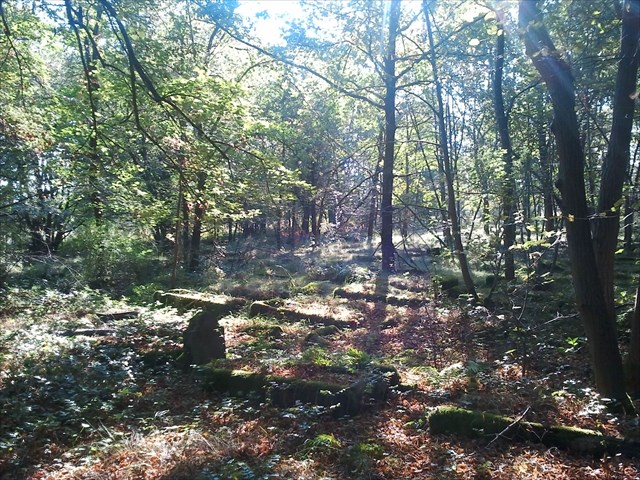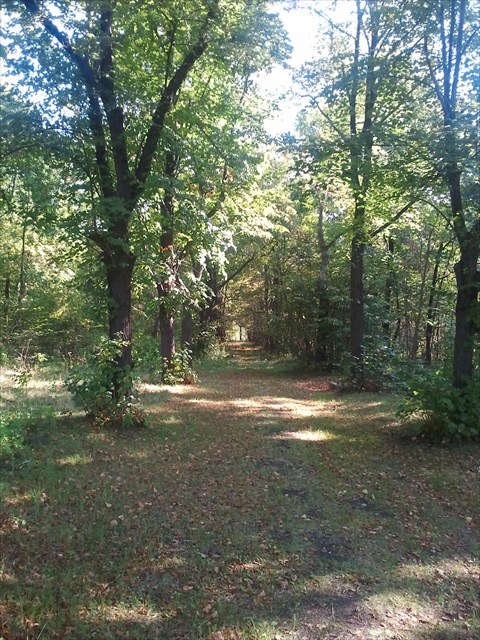-HP- Cmentarz Zasieki/Friedhof Berge Traditional Cache
-HP- Cmentarz Zasieki/Friedhof Berge
-
Difficulty:
-

-
Terrain:
-

Size:  (regular)
(regular)
Please note Use of geocaching.com services is subject to the terms and conditions
in our disclaimer.
 W 1897 roku wioska Berge została wcielona do miasta Forst / Lausitz. Nowa dzielnica położona na wschodnim brzegu Nysy początkowo miała charakter wiejski. Stopniowo rozwijała się i ostatecznie została przekształcona w Forster Neustadt. W latach 20-tych uruchomiono program który zaowocował wybudowaniem 10 nowych dróg i przerzuceniem przez Nysę w 1922 r. betonowego mostu "Lange Brücke" (czyli długi most), po ukonczenieu ktorego wokół "Tuchmacherbrunnen" ( czyli fontanna sukienników) powstalo nowe centrum miasta wraz z urzedem skarbowym.
W 1897 roku wioska Berge została wcielona do miasta Forst / Lausitz. Nowa dzielnica położona na wschodnim brzegu Nysy początkowo miała charakter wiejski. Stopniowo rozwijała się i ostatecznie została przekształcona w Forster Neustadt. W latach 20-tych uruchomiono program który zaowocował wybudowaniem 10 nowych dróg i przerzuceniem przez Nysę w 1922 r. betonowego mostu "Lange Brücke" (czyli długi most), po ukonczenieu ktorego wokół "Tuchmacherbrunnen" ( czyli fontanna sukienników) powstalo nowe centrum miasta wraz z urzedem skarbowym.
W dzielnicy Berge funkcjonowały kluby piłkarskie Askania (przed pierwszą wojną światową) i Viktoria Forst (w okresie międzywojennym) które jako Mistrzowie południowo-wschodniej części kraju, reprezentowały ten region na Mistrzostwach Niemiec w piłce nożnej.
W lutym 1945 r. oddziały radzieckie dotarły na wschodni brzeg Nysy Łużyckiej, a samo miasto zostało zajęte między 16 a 18 kwietnia. Zniszczeniu uległo 85% zabudowy miejskiej, dzielnica Berge praktycznie przestała istnieć i a zajmowany przez nią teren odtąd należał do Polski.
Do dziś przetrwały pojedyncze domy wybudowane w latach 20-30 i ten cmentarz.
Cmentarz nadal jest użytkowany, a na jego końcu można znaleźć niemal nienaruszone miejsca pochowku dawnych mieszkańców miasta, zarówno protestantów jak i Żydów, z tym ze teraz stare pomniki nagrobne stały się swego rodzaju ogrodzeniem odnowionej brukowanej uliczki. Uliczka ta nosiła wcześniej nazwę Lange Straße i była obok Pförtener Straße i Breiten Straße jedna z trzech głównych ulic tej części miasta Czy jakieś miejsce możne lepiej okazać skutki wojny?
"Wielka Kartagina stoczyła trzy wojny. Po pierwszej wciąż była silna, po drugiej, nadal nadawała się do zamieszkania, po trzeciej była nie do odnalezienia."
Bertolt Brecht (* 10.02.1898, † 14.08.1956) w liście otwartym do niemieckich artystów i pisarzy, 1951.
Trwajmy w nadziei i żyjmy po to, by Forst nie doświadczyło trzeciej wojny.
Special Thanks to Diabel_DLU for translation.

 1897 wurde das Dorf Berge in das Stadtgebiet von Forst/Lausitz eingemeindet. Der neue Stadtteil am östlichen Neißeufer hatte anfangs noch einen dörflichen Charakter, entwickelte sich stetig zur Forster Neustadt. In den 20er-Jahren entstanden durch ein Neubauprogramm 10 neue Straßen. Mit der Fertigstellung der Langen Brücke im Jahr 1922 entstand um den Tuchmacherbrunnen ein neues Stadtzentrum mit Finanzamt.
1897 wurde das Dorf Berge in das Stadtgebiet von Forst/Lausitz eingemeindet. Der neue Stadtteil am östlichen Neißeufer hatte anfangs noch einen dörflichen Charakter, entwickelte sich stetig zur Forster Neustadt. In den 20er-Jahren entstanden durch ein Neubauprogramm 10 neue Straßen. Mit der Fertigstellung der Langen Brücke im Jahr 1922 entstand um den Tuchmacherbrunnen ein neues Stadtzentrum mit Finanzamt.
Ebenfalls im Stadtteil Berge kämpften die Vereine Askania (vor dem 1. Weltkrieg) und Viktoria Forst (zwischen den Weltkriegen) als Südostdeutsche Meister um die Deutsche Meisterschaft im Fußball.
Im Februar 1945 erreichten sowjetische Truppen das östliche Neißeufer, die Stadt selbst wurde vom 16.-18. April eingenommen. Danach waren 85% der Stadt zerstört. Der Stadtteil Berge existierte fast nicht mehr und gehörte fortan zu Polen.
Heute existieren nur noch einzelne Häuser der in den 20er und 30er Jahren erbauten Stadtrandsiedlungen und dieser Friedhof. Der Friedhof wird im vorderen Teil immer noch als Friedhof genutzt. Der hintere Teil mit den alten Gräbern, sowohl evangelischer als auch jüdischer Mitbürger ist fast unberührt erhalten geblieben, wenn man einmal davon absieht, daß die alten Grabeinfriedungen heute offensichtlich als Zaun an der renovierten Kopfsteinpflaster-Straße genutzt werden. Diese Straße hieß früher einmal Lange Straße und war neben der Pförtener Straße und der Breiten Straße eine der drei Hauptstraßen dieses Stadtteiles.
Wo könnte man die Folgen von Krieg besser sehen als hier?
„Das große Karthago führte drei Kriege. Nach dem ersten war es noch mächtig. Nach dem zweiten war es noch bewohnbar. Nach dem dritten war es nicht mehr aufzufinden.“
Bertolt Brecht (* 10.02.1898, † 14.08.1956) in einem Offenen Brief an die deutschen Künstler und Schriftsteller, 1951
Hoffen und leben wir dafür, daß Forst keinen dritten Krieg erlebt.

 In 1897 the village Berge was suburbanized to the city of Forst / Lausitz. The new district on the eastern bank of the Neisse had initially a village character. Due to continously development the city district grew up, and became finally to Forster Neustadt. In the 20's the city launched a program to built 10 new roads. With the completion of a new concrete bridge ("Lange Brücke" means long bridge) in 1922, was also built a new city center around the "Tuchmacherbrunnen" (means clothier-fountain) with the tax office.
In 1897 the village Berge was suburbanized to the city of Forst / Lausitz. The new district on the eastern bank of the Neisse had initially a village character. Due to continously development the city district grew up, and became finally to Forster Neustadt. In the 20's the city launched a program to built 10 new roads. With the completion of a new concrete bridge ("Lange Brücke" means long bridge) in 1922, was also built a new city center around the "Tuchmacherbrunnen" (means clothier-fountain) with the tax office.
Also in the district Berge fought clubs Askania (before WW1) and Viktoria Forst (between the wars) than Southeast German champions in the finals of the German championship in football.
In February 1945, Soviet troops reached the eastern shore of the river Neisse, the city itself was taken between 16th-18th April. After the battle 85% of the city was destroyed. The district Berge was almost no more existing, and henceforth the area belonged to Poland.
Today exist yet only some houses from the suburban settlement, built in the 20s and 30s, and this cemetery. The cemetery is partly still used as a cemetery. But the rear part with ancient tombs from Protestant as well as Jewish citizens was remained almost untouched. However you'll find some of the old grave fences in front of the cemetery at the renovated cobblestone street. This road was once the "Lange Starße" (menas long street), and was next to the "Breite Straße" (means broad street) and the "Pförtener Straße" (means the road in direction Brody) one of the three main streets of this city part.
Where you can see the consequences of war better than here?
"The great Carthage waged three wars. It was still powerful after the first, still habitable after the second. It was untraceable after the third."
Bertolt Brecht (* 10.02.1898, † 08.14.1956) in an open letter to the German artists and writers, 1951
We hope and we live for, that Forst experienced no third war.

Additional Hints
(Decrypt)
va gur gerr, jrfg fvqr sebz gur fgbar oybpx
fvapr gur bevtvany pbagnvare bar unf orra ybfg, abj vg'f whfg n crgyvat